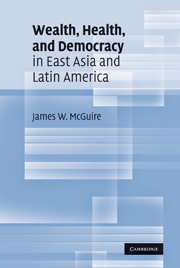Book contents
- Frontmatter
- Contents
- Figures and Tables
- Preface and Acknowledgments
- Abbreviations
- 1 Incomes, Capabilities, and Mortality Decline
- 2 Democracy, Spending, Services, and Survival
- 3 Costa Rica: A Healthy Democracy
- 4 Chile: The Pinochet Paradox
- 5 Argentina: Big Welfare State, Slow Infant Mortality Decline
- 6 Brazil: From Laggard to Leader in Basic Health Service Provision
- 7 Taiwan: From Poor but Healthy to Wealthy and Healthy
- 8 South Korea: Small Welfare State, Fast Infant Mortality Decline
- 9 Thailand: Democratization Speeds Infant Mortality Decline
- 10 Indonesia: Authoritarianism Slows Infant Mortality Decline
- 11 Wealth, Health, Democracy, and Mortality
- Appendix Tables
- Works Cited
- Index
8 - South Korea: Small Welfare State, Fast Infant Mortality Decline
Published online by Cambridge University Press: 06 July 2010
- Frontmatter
- Contents
- Figures and Tables
- Preface and Acknowledgments
- Abbreviations
- 1 Incomes, Capabilities, and Mortality Decline
- 2 Democracy, Spending, Services, and Survival
- 3 Costa Rica: A Healthy Democracy
- 4 Chile: The Pinochet Paradox
- 5 Argentina: Big Welfare State, Slow Infant Mortality Decline
- 6 Brazil: From Laggard to Leader in Basic Health Service Provision
- 7 Taiwan: From Poor but Healthy to Wealthy and Healthy
- 8 South Korea: Small Welfare State, Fast Infant Mortality Decline
- 9 Thailand: Democratization Speeds Infant Mortality Decline
- 10 Indonesia: Authoritarianism Slows Infant Mortality Decline
- 11 Wealth, Health, Democracy, and Mortality
- Appendix Tables
- Works Cited
- Index
Summary
South Korea and Taiwan fared differently on mortality in the 1950s. In Taiwan, the Sino-American Joint Commission on Rural Reconstruction introduced primary health care and disease control initiatives that contributed to rapid mortality decline. In Korea, war in the early 1950s cost nearly 3 million lives, including nearly a million civilian dead in South Korea. The stark difference in the fortunes of the two societies helps to explain why, in 1960, infant mortality was 54 per 1000 in Taiwan, but 90 per 1000 in South Korea.
After recovering from the Korean War, South Korean governments, which were semi-democratic during the 1950s and 1960s but highly authoritarian from 1972 to 1986, relied in their efforts to improve the well-being of the population not only on “shared growth” – a rapid rise in GDP per capita coupled with an even distribution of income – but also on the provision of basic social services. Working together to improve the well-being of the initially poor were the public provision of primary and secondary education after the late 1950s, family planning after the mid-1960s, water and sanitation after the early 1970s, and maternal and infant care after the late 1970s. A combination of shared growth and social provisioning, rather than shared growth alone, explains why, from 1960 to 2005, South Korea had the steepest infant mortality decline and the lowest 2005 infant mortality level among the eight societies compared in this book.
- Type
- Chapter
- Information
- Wealth, Health, and Democracy in East Asia and Latin America , pp. 203 - 227Publisher: Cambridge University PressPrint publication year: 2010



